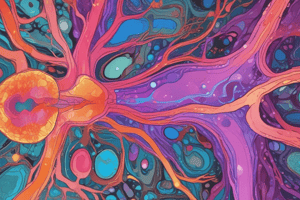Podcast
Questions and Answers
Which immunofluorescence pattern is associated with Goodpasture syndrome?
Which immunofluorescence pattern is associated with Goodpasture syndrome?
- Focal segmental sclerosis pattern
- Negative IF (pauci-immune)
- Granular (immune complex deposition)
- Linear (anti-basement membrane antibody) (correct)
Which of the following diseases is most commonly associated with granular immunofluorescence patterns?
Which of the following diseases is most commonly associated with granular immunofluorescence patterns?
- Goodpasture syndrome
- Post-streptococcal glomerulonephritis (PSGN) (correct)
- Churg-Strauss syndrome
- Wegener granulomatosis
Which condition is characterized by a negative immunofluorescence finding?
Which condition is characterized by a negative immunofluorescence finding?
- Goodpasture syndrome
- Wegener granulomatosis (correct)
- Diffuse proliferative glomerulonephritis
- Post-streptococcal glomerulonephritis (PSGN)
Which characteristic helps distinguish Churg-Strauss syndrome from microscopic polyangiitis?
Which characteristic helps distinguish Churg-Strauss syndrome from microscopic polyangiitis?
In the context of rapidly progressive glomerulonephritis, which pattern is commonly associated with systemic lupus erythematosus (SLE)?
In the context of rapidly progressive glomerulonephritis, which pattern is commonly associated with systemic lupus erythematosus (SLE)?
Flashcards
Goodpasture Syndrome
Goodpasture Syndrome
A type of rapidly progressive glomerulonephritis characterized by linear staining with anti-basement membrane antibodies.
Linear Immunofluorescence
Linear Immunofluorescence
A pattern seen in immunofluorescence where antibodies are deposited along the basement membrane of the glomeruli, appearing as a continuous line.
Post-Streptococcal Glomerulonephritis (PSGN)
Post-Streptococcal Glomerulonephritis (PSGN)
The most common form of rapidly progressive glomerulonephritis caused by immune complex deposition.
Granular Immunofluorescence
Granular Immunofluorescence
Signup and view all the flashcards
Pauci-Immune Glomerulonephritis
Pauci-Immune Glomerulonephritis
Signup and view all the flashcards
Study Notes
Immunofluorescence Findings in Rapidly Progressive Glomerulonephritis
-
Linear Pattern: Associated with Goodpasture syndrome. Antibodies target the basement membrane, often causing hematuria and hemoptysis, particularly in young to middle-aged males.
-
Granular Pattern: Most commonly linked to PSGN (post-streptococcal glomerulonephritis) or diffuse proliferative glomerulonephritis. Immune complex deposition is the primary feature, usually sub-endothelial. It is a frequent type of kidney disease seen in systemic lupus erythematosus (SLE).
-
Negative Immunofluorescence (Pauci-immune): Linked to conditions like Wegener's granulomatosis, microscopic polyangiitis, and Churg-Strauss syndrome. These conditions are characterized by granulomatous inflammation, often with eosinophilia and asthma (in Churg-Strauss). Different types of antineutrophil cytoplasmic antibodies (ANCA) are associated: c-ANCA for Wegener's, and p-ANCA for microscopic polyangiitis and Churg-Strauss.
Studying That Suits You
Use AI to generate personalized quizzes and flashcards to suit your learning preferences.




